Note: Poster #'s 19 and 20 are cross-listed in the judging category of Innovative Solutions to Public Health Challenges.
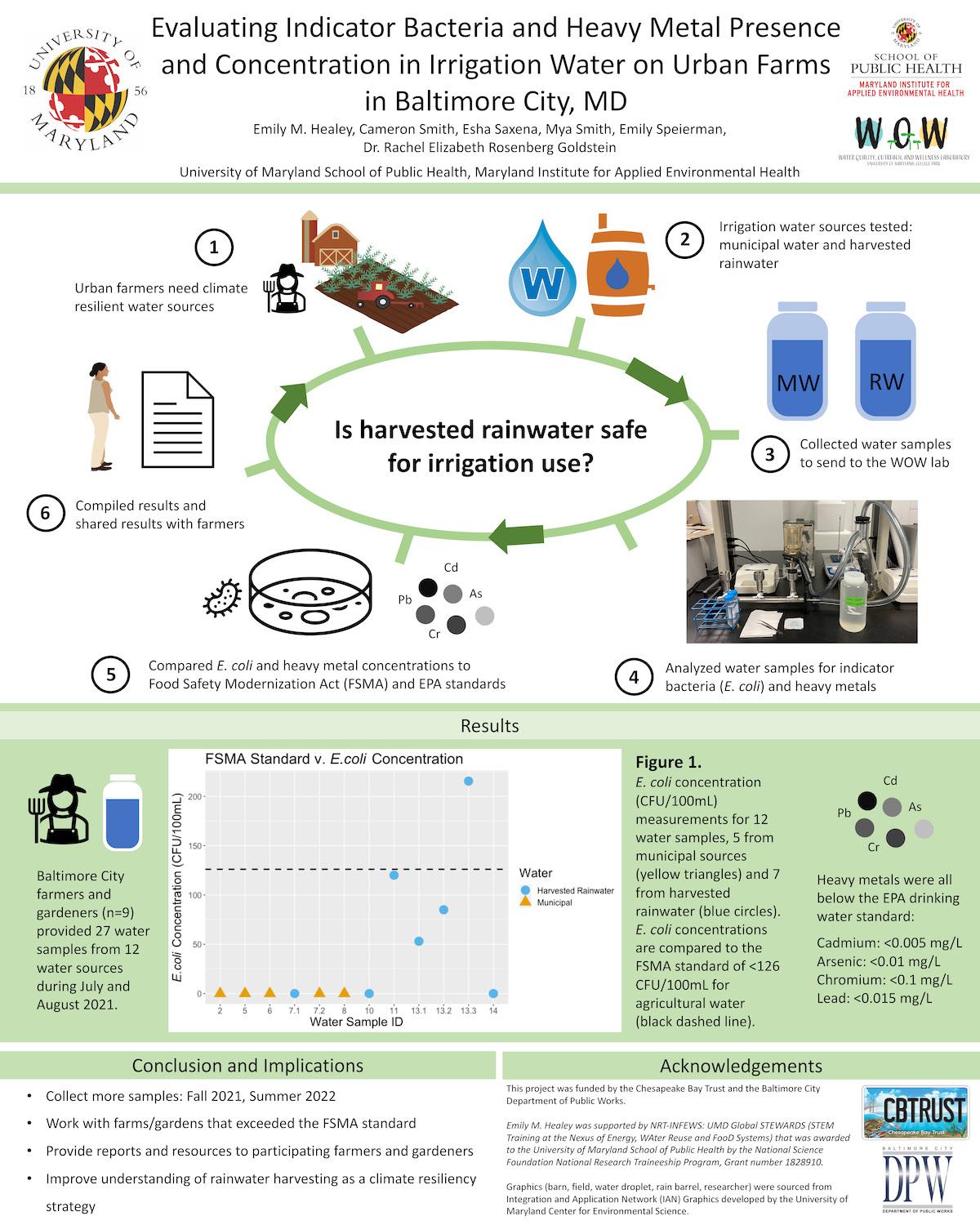
Poster # 19
Title: Evaluating Indicator Bacteria and Heavy Metal Presence and Concentration in Irrigation Water on Urban Farms in Baltimore City, MD
Presenting Author: Emily Healey (UMD SPH Doctoral Student in the Maryland Institute of Applied Environmental Health)
Authors: Cameron Smith, University of Maryland, SPH MIEAH, Graduate Student; Esha Saxena, University of Maryland, CMNS, Undergraduate Student; Mya Smith, University of Maryland, CMNS, Undergraduate Student; Emily Speierman, University of Maryland, Department of Engineering, Undergraduate Student
Faculty Mentor: Dr. Rachel Rosenberg Goldstein
Primary Category: Environmental Health, Occupational Health, Environmental Justice and Climate Change
Secondary Category: Innovative Solutions to Public Health Challenges
Background: Alternative water sources are imperative to addressing climate change’s impacts on freshwater accessibility and availability. Harvesting rainwater could provide cost-effective irrigation water for urban farms, which experience challenges with irrigation costs and water availability.
Goal: To protect farmers and consumer health, it is critical to evaluate the water quality of the harvested rainwater.
Objectives: Our project aims to test the quality of irrigation water sources used by Baltimore City farmers and gardeners (n=9).
Approach/Methods: Through this project, water samples (n=27) from each water source on partner sites were collected and tested for total coliforms, E. coli, and heavy metals (arsenic, cadmium, chromium, and lead).
Results: Preliminary results showed that only one sample (1/27; 4%) from one of the 12 sites (8%) had an E. coli concentration (CFU/100mL) above the Food Safety Modernization Act (FSMA) standard for agricultural water. All samples tested were below the drinking water standards for heavy metals.
Importance to Public Health: These results contribute to the knowledge urban farmers need to make decisions on irrigation sources.
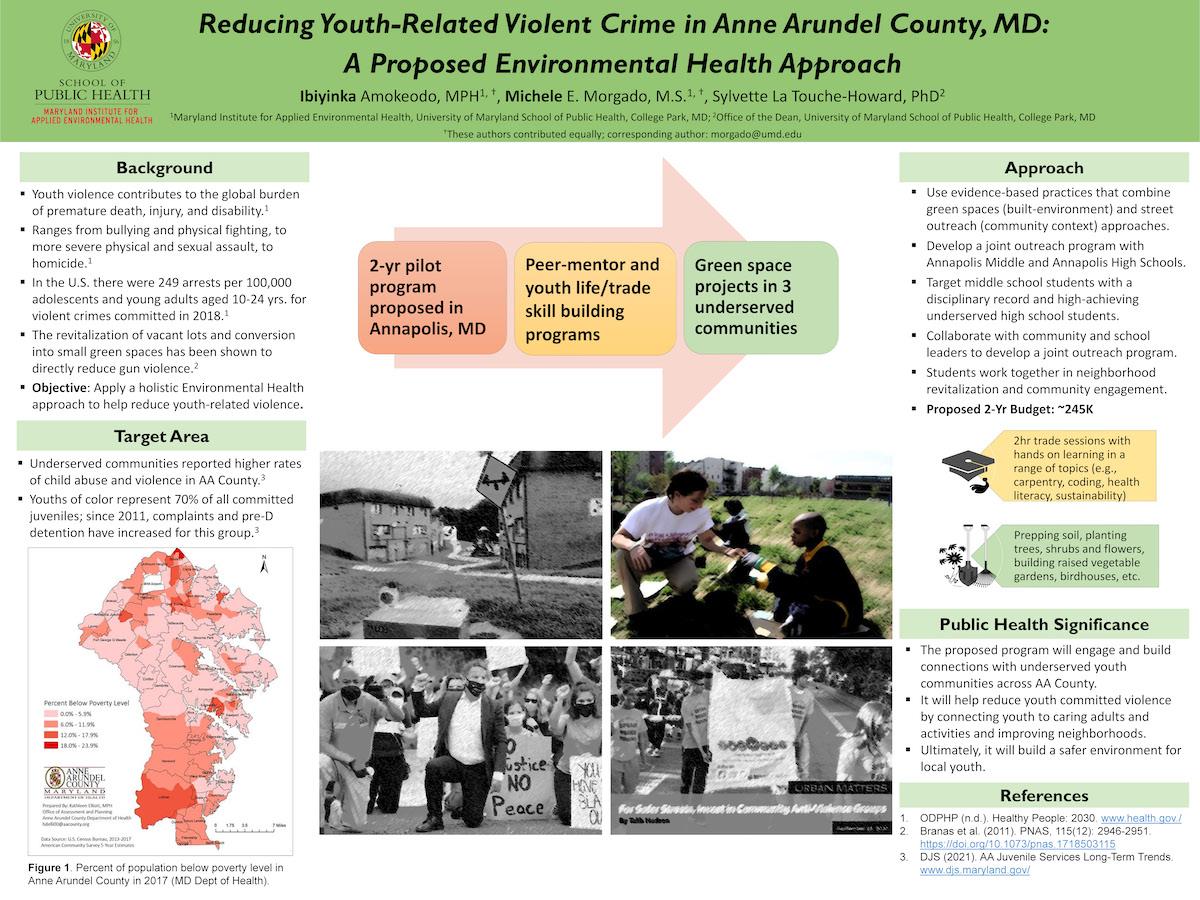
Poster # 20
Title: Reducing Youth-Related Violent Crime in Anne Arundel County, MD: A Proposed Environmental Health Approach
Presenting Author: Michele Morgado (UMD PSH Doctoral Student
Authors: Ibiyinka Amokeodo, Maryland Institute for Applied Environmental Health, UMD School of Public Health, Doctoral Student; Sylvette La Touche-Howard, Office of the Dean, UMD School of Public Health, Faculty
Faculty Mentors: Dr. Sylvette La Touche-Howard
Primary Category: Environmental Health, Occupational Health, Environmental Justice and Climate Change
Secondary Category: Innovative Solutions to Public Health Challenges
Background: Youth violence is a major contributor to the global burden of premature death, injury, and disability. This may lead to increased costs in healthcare, welfare, and criminal justice services. In the U.S. alone, there were 249 arrests per 100,000 adolescents and young adults (ages 10-24 years old) for violent crimes committed in 2018.
Goal: As a result, Healthy People 2030 set a target to reduce the number of arrests and youth violent crimes by 20% by applying evidence-based strategies.
Objectives: Through a project-based study we identified areas and communities at a higher risk of experiencing youth related violent crime and proposed an environmental health approach to help reduce violence and improve overall quality of life.
Approach/Methods: The target area, Anne Arundel (AA) County, is the fifth largest county in the state of Maryland (MD) with an estimated 9.3% children living below the poverty line, and an average of 444 children abused or neglected each year. Although MD per capita violent crimes committed by juveniles have declined since 2010, AA County has seen increasing trends. These are especially significant for youths of color, which represent roughly 70% of all committed juveniles. Our proposed project uses an Environmental Health approach that incorporates elements from place-based interventions and community outreach programs.
Results: The initial phase includes a 2-year pilot program in Annapolis, MD with a joint outreach collaboration between Annapolis Middle and Annapolis High schools. A teacher liaison, a social and behavioral specialist and an outreach worker will aid in program coordination. Middle school students with a disciplinary record will be paired with high-achieving underserved high school students for a peer-mentoring support. Another integral aspect will include students working together in neighborhood revitalization projects for 3 underserved communities, and their participation in life and trade building skill programs.
Importance to Public Health: The proposed program will engage and build connections with underserved youth communities across AA County. Based on prior successful strategies, it will also help reduce youth committed violence by connecting youth to caring adults and activities. Ultimately, it will enhance the quality of the neighborhood and built environment while addressing the social needs of juveniles in our target communities.
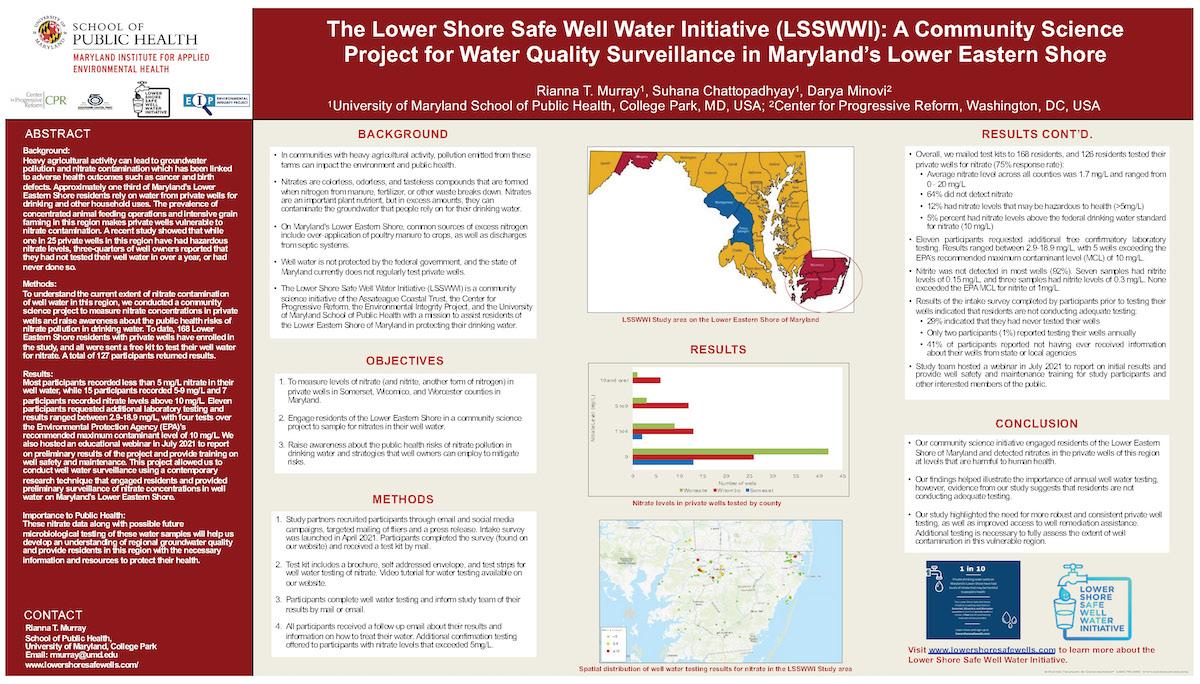
Poster # 21
Title: The Lower Shore Safe Well Water Initiative (LSSWWI): A Community Science Project for Water Quality Surveillance in Maryland’s Lower Eastern Shore
Presenting Author: Rianna Murray (UMD SPH Faculty member, Maryland Institute for Applied Environmental Health)
Authors: Suhana Chattopadhyay, PhD Student, MIAEH; Darya Minovi, community partner, Center for Progressive Reform
Faculty Mentors: None
Primary Category: Environmental Health, Occupational Health, Environmental Justice and Climate Change
Secondary Category: None
Background: Heavy agricultural activity can lead to groundwater pollution and nitrate contamination which has been linked to adverse health outcomes such as cancer and birth defects. Approximately one third of Maryland’s Lower Eastern Shore residents rely on water from private wells for drinking and other household uses. The prevalence of concentrated animal feeding operations and intensive grain farming in this region makes private wells vulnerable to nitrate contamination.
Goal: To understand the current extent of nitrate contamination of private well water in the Lower Eastern Shore of Maryland.
Objectives:
- To measure levels of nitrate (and nitrite, another form of nitrogen) in private wells in Somerset, Wicomico, and Worcester counties in Maryland.
- Engage residents of the Lower Eastern Shore in a community science project to sample for nitrates in their well water.
- Raise awareness about the public health risks of nitrate pollution in drinking water and strategies that well owners can employ to mitigate risks.
Approach/Methods: We conducted a community science project to measure nitrate concentrations in private wells and raise awareness about the public health risks of nitrate pollution in drinking water. To date, 168 Lower Eastern Shore residents with private wells have enrolled in the study, and all were sent a free kit to test their well water for nitrate. A total of 127 participants returned results.
Results: Most participants recorded less than 5 mg/L nitrate in their well water, while 15 participants recorded 5-9 mg/L and 7 participants recorded nitrate levels above 10 mg/L. Eleven participants requested additional laboratory testing and results ranged between 2.9-18.9 mg/L, with four tests over the Environmental Protection Agency (EPA)’s recommended maximum contaminant level of 10 mg/L. We also hosted an educational webinar in July 2021 to report on preliminary results of the project and provide training on well safety and maintenance. This project allowed us to conduct well water surveillance using a contemporary research technique that engaged residents and provided preliminary surveillance of nitrate concentrations in well water on Maryland’s Lower Eastern Shore.
Importance to Public Health: These nitrate data along with possible future microbiological testing of these water samples will help us develop an understanding of regional groundwater quality and provide residents in this region with the necessary information and resources to protect their health.
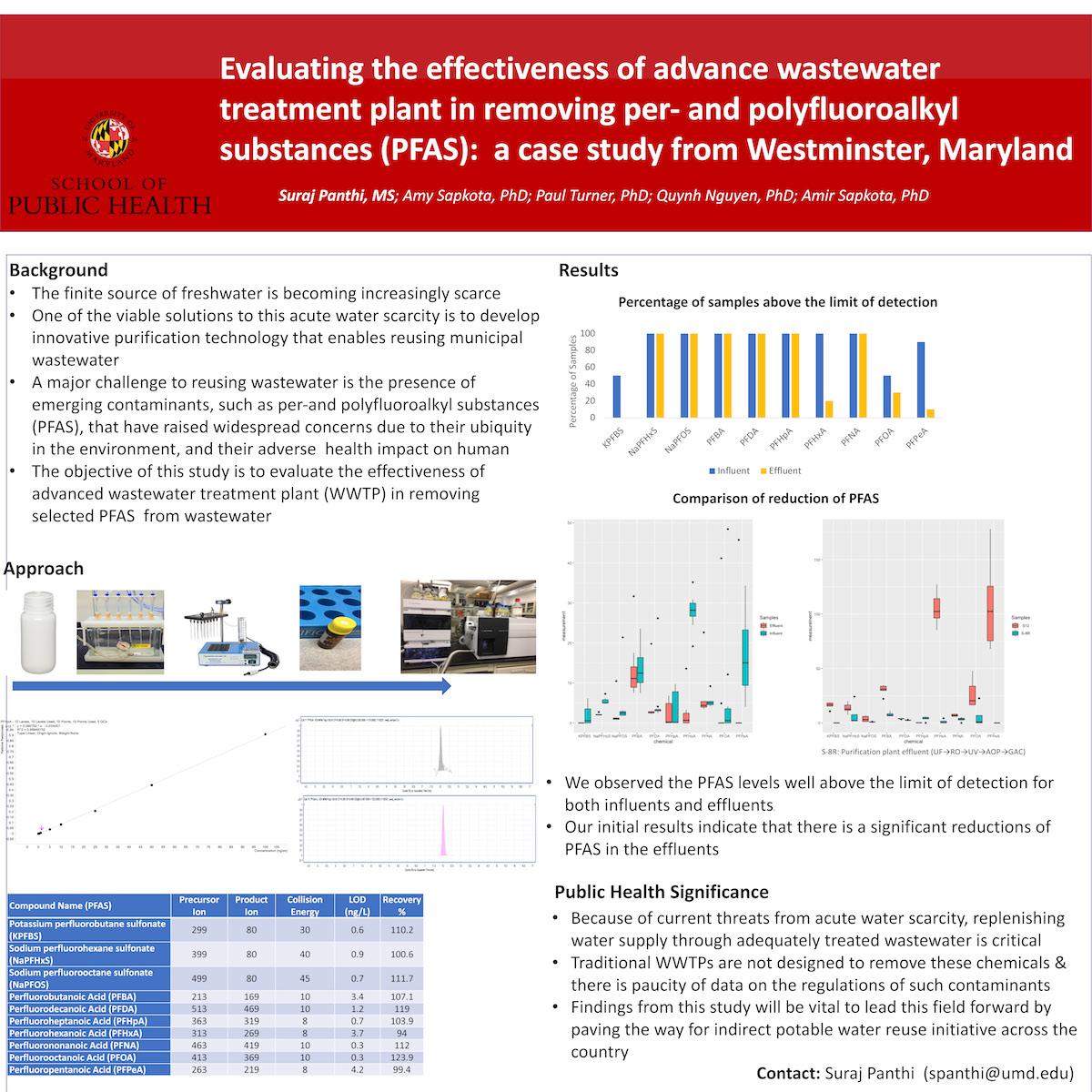
Poster # 22
Title: Evaluating the effectiveness of advance wastewater treatment plant in removing Per- and Polyfluoroalkyl Substances (PFAS): a case study from Westminster, Maryland
Presenting Author: Suraj Panthi (UMD SPH Doctoral Students, Maryland Institute for Applied Environmental Health)
Authors: Dr. Amy Sapkota
Faculty Mentors: Dr. Amir Sapkota
Primary Category: Environmental Health, Occupational Health, Environmental Justice and Climate Change
Secondary Category: None
Background: The finite source of global freshwater is becoming increasingly scarce due to several competing factors, such as growing population, urbanization, water pollution, and climate change. Therefore, it is critical to identify alternate sources of water supply, and develop innovative purification technology that enables reusing municipal wastewater. However, a major challenge to reusing wastewater is the presence of emerging contaminants, such as per-and polyfluoroalkyl substances (PFAS), that are ubiquitous in the environment, and pose public health threat. The objective of this study is to evaluate the effectiveness of advanced waste water treatment plant (WWTP) in removing selected PFAS from wastewater.
Goal: To evaluate the effectiveness of advanced waste water treatment plant (WWTP) in removing selected PFAS from wastewater.
Objectives: Compared to the influents, concentration of PFAS will be significantly lower in effluents from the newly developed WWTP.
Approach/Methods: We collected 250 mL influent and effluent water samples every other week for six months (N=61) from a newly developed advance WWTP in Westminster, Maryland. We processed the water samples using solid phase extraction (SPE), and analyzed them using liquid chromatography tandem mass spectrometry (LC-MS/MS) based method. We will use two sample t-test to show significant reduction in concentration in the effluent samples.
Results: Our preliminary data suggest that the advanced WWTP currently being evaluated in Westminster MD significantly reduces PFAS concentration. For example, concentration of PFHxA in effluent samples decreased by 87.6% compared to influent samples (3.3 ng/L vs 26.7 ng/L). Similar results were observed for other PFAS as well.
Importance to Public Health: Alternate water sources, such as adequately treated wastewater is needed to alleviate water scarcity issues that is being exacerbated by ongoing climate change. However, presence of emerging contaminants such as PFAS remain a major roadblock in using municipal wastewater. Findings from this study suggest that advance WWTP may overcome this hurdle, and pave the way for wastewater reuse.
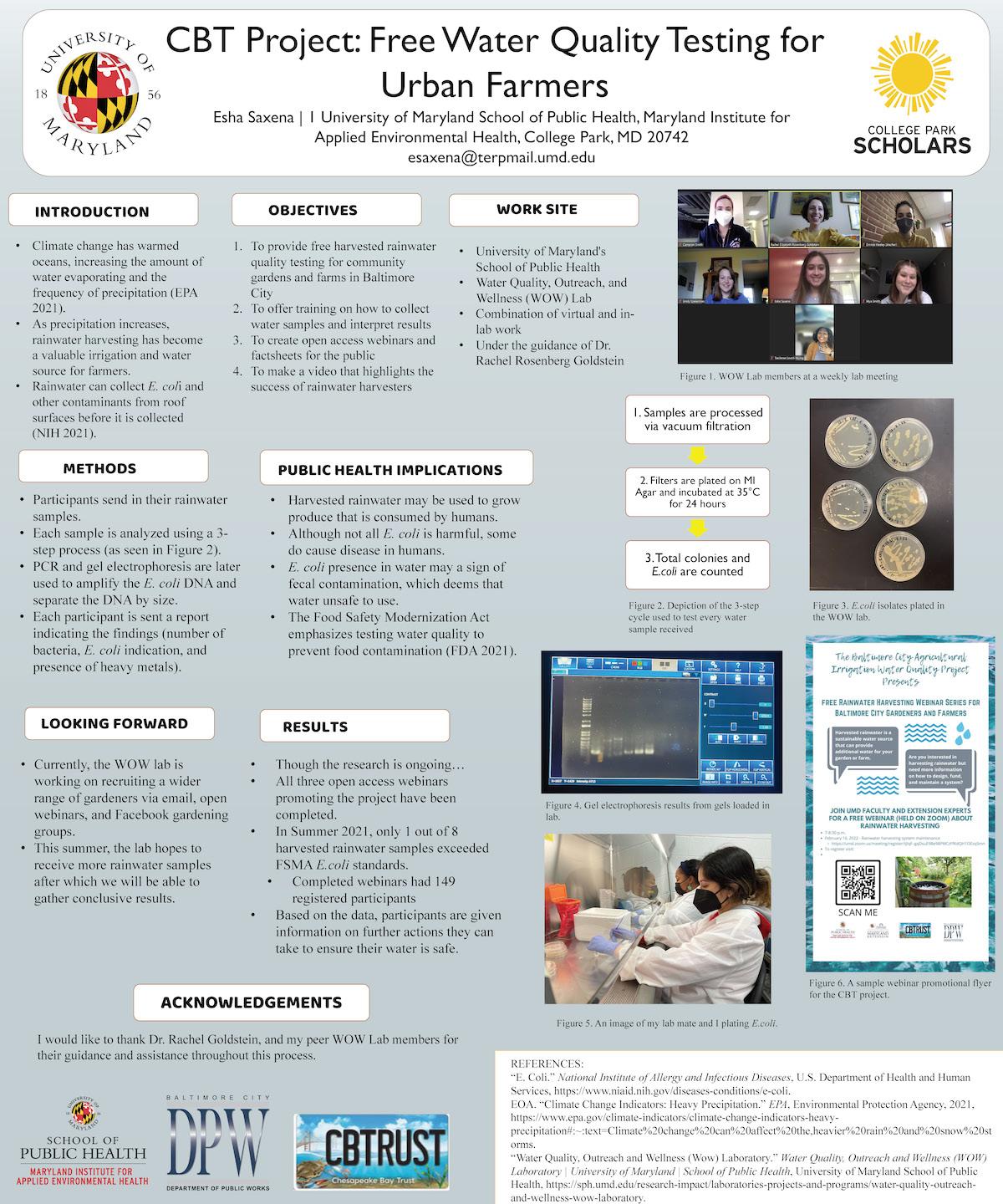
Poster # 23
Title: CBT Project: Free Water Quality Testing for Urban Farmers
Presenting Author: Esha Saxena (UMD Undergraduate Student in Neuroscience)
Authors: None
Faculty Mentors: Dr. Rachel Rosenberg Goldstein
Primary Category: Environmental Health, Occupational Health, Environmental Justice and Climate Change
Secondary Category: Health Literacy, Health Communication, Health Education
Background: Precipitation increase due to climate change has made harvested rainwater a promising water source for farms. Harvested rainwater, however, may be susceptible to E.coli and heavy metal presence- which is then consumed by those who rely on the crops of the farmers.
Goal: The overall goal is to provide free harvested rainwater testing for community gardeners and famers in Baltimore City.
Objectives:
- To provide free harvested rainwater quality testing for community gardens and farms in Baltimore City
- To offer training on how to collect water samples and interpret results
- To create open access webinars and factsheets for the public
- To make a video that highlights the success of rainwater harvesters
Approach/Methods: Participants were recruited via social media and webinars and were instructed to collect samples of their harvested rainwater. Samples are then processed via vacuum filtration, filters are plated and incubated, and then total colonies and E. coli are counted. Participants are sent report sheets on the findings and are given future directions.
Results: All three open access webinars have been completed with a total of 149 registered participants. In summer 2021, only 1 out of 8 tested harvested rainwater samples exceeded FSMA E.coli standards.
Importance to Public Health: With the world turning towards using recycled water sources, harvested rainwater has the potential to be a useful water source for gardening and farming. Testing for E.coli and heavy metal presence can give the public a clearer picture of what is being used to grow consumed produce.
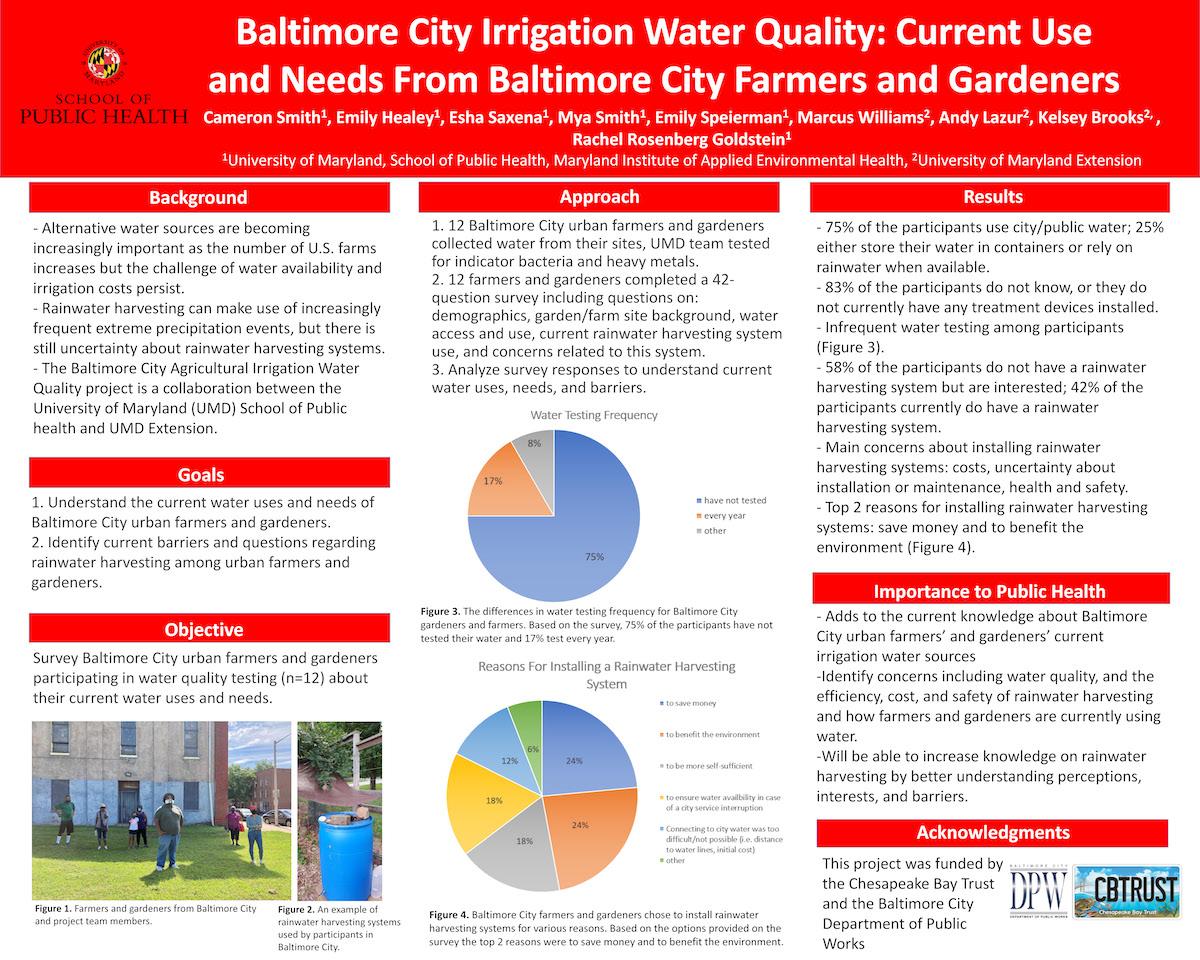
Poster # 24
Title: Baltimore City Irrigation Water Quality: Current Use and Needs From Baltimore City Farmers and Gardeners
Presenting Author: Cameron Smith (UMD SPH Master's Student, Maryland Institute for Applied Environmental Health)
Authors: Emily Healey, University of Maryland, School of Public Health, Maryland Institute of Applied Environmental Health, Student; Esha Saxena, University of Maryland College Park, Student; Mya Smith, University of Maryland College Park, Student; Emily Speierman, University of Maryland College Park, Student; Marcus Williams, University of Maryland Extension, Extension Agent; Kelsey Brooks, University of Maryland Extension, Extension Agent
Faculty Mentors: Dr. Rachel Rosenberg Goldstein
Primary Category: Environmental Health, Occupational Health, Environmental Justice and Climate Change
Secondary Category: Data Analytics, Surveillance, Community Needs Assessment, Pedagogy
Background: The number of U.S. urban farms is increasing, yet irrigation costs and water availability are critical challenges for these farmers. Rainwater harvesting could address urban farm water constraints. Despite farmers’ interest in rainwater harvesting, it remains uncommon among urban farmers. It is critical to understand barriers to rainwater harvesting among urban farmers.
Goal: The goal of this project is to understand the current water uses and needs of Baltimore City urban farmers and gardeners and identify current barriers and questions regarding rainwater harvesting among urban farmers and gardeners.
Objectives: Survey Baltimore City urban farmers and gardeners participating in water quality testing (n=12) about their current water uses and needs.
Approach/Methods: 12 Baltimore City urban farmers and gardeners collected water from their sites to test irrigation water source quality for indicator bacteria and heavy metals. Participants completed a survey answering questions related to the background of their gardens, water access and use, and use of rainwater harvesting systems.
Results: Preliminary results found that these farmers and gardeners are concerned about water costs and availability. Participants wanted to be involved in this project for various reasons, but primarily related to the health or safety of their irrigation water. Based on these findings, Baltimore City farmers and gardeners also have questions about harvested rainwater use such as the safety, maintenance, and cost.
Importance to Public Health: This project adds to the current knowledge about urban farmers needs regarding irrigation water sources.
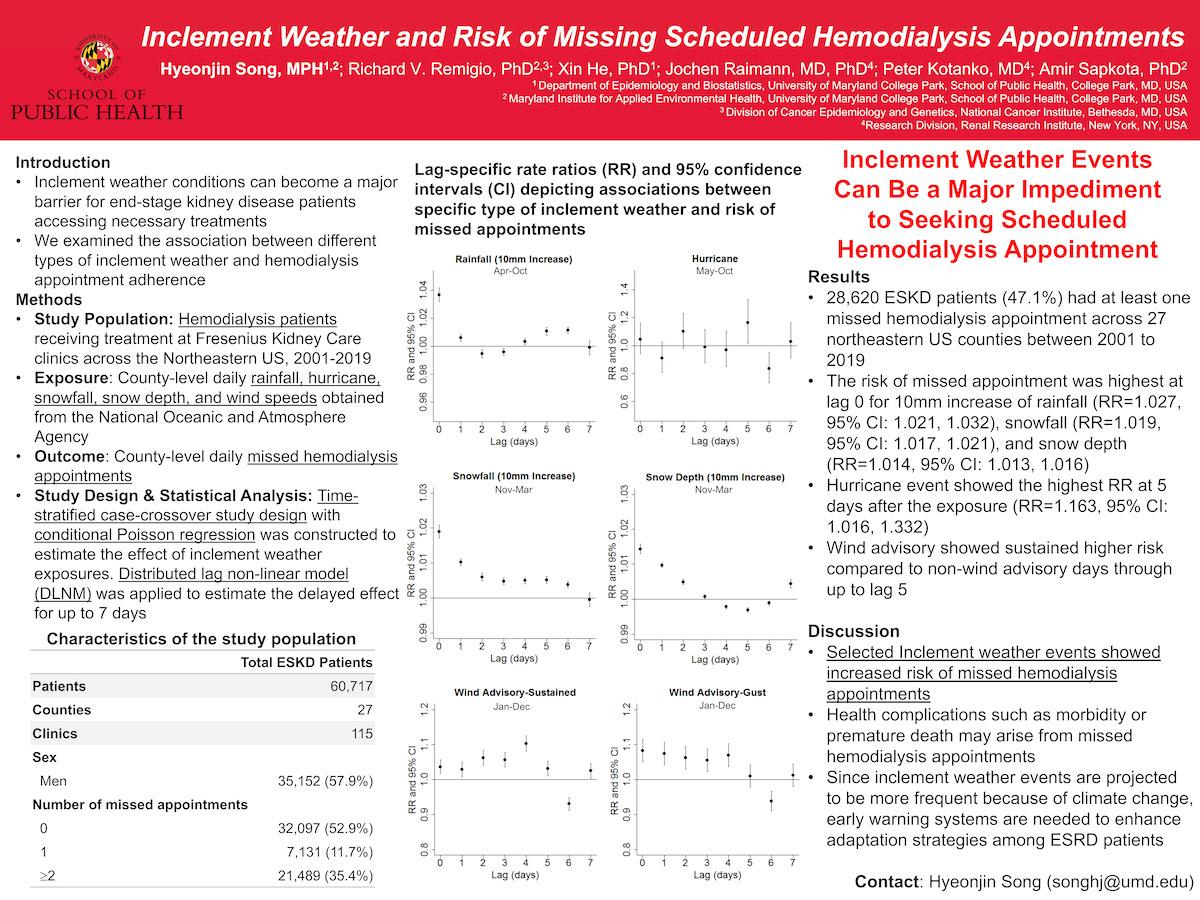
Poster # 25
Title: Inclement Weather and Risk of Missing Scheduled Hemodialysis Appointments
Presenting Author: Hyeonjin Song (UMD PSH Doctoral Student, Epidemiology and Biostatistics)
Authors: Richard V. Remigio, PhD, Maryland Institute for Applied Environmental Health, University of Maryland College Park, School of Public Health, College Park, MD, USA; Division of Cancer Epidemiology and Genetics, National Cancer Institute, Bethesda, MD, USA; Xin He, PhD, Department of Epidemiology and Biostatistics, University of Maryland College Park, School of Public Health, College Park, MD, USA; Jochen Raimann, MD; Research Division, Renal Research Institute, New York, NY, USA; Peter Kotanko, MD, Research Division, Renal Research Institute, New York, NY, USA; Amir Sapkota, PhD, Maryland Institute for Applied Environmental Health, University of Maryland College Park, School of Public Health, College Park, MD, USA
Faculty Mentors: Dr. Amir Sapkota
Primary Category: Environmental Health, Occupational Health, Environmental Justice and Climate Change
Secondary Category: None
Background: Non-adherence to hemodialysis appointments could potentially result in health complications that can influence morbidity and death.
Goal: We examined the association between different types of inclement weather and hemodialysis appointment adherence.
Approach/Methods: We obtained health records on end-stage kidney disease (ESKD) patients who received hemodialysis treatment at Fresenius Kidney Care (FKC) clinics across the Northeastern U.S. during 2001-2019. County-level daily meteorological data on rainfall, hurricane events, snowfall, snow depth, and wind speed were extracted through the National Oceanic and Atmosphere Agency (NOAA). A time-stratified case-crossover study design with conditional Poisson regression was employed to estimate the effect of inclement weather exposures within the northeastern U.S. region. We applied distributed lag non-linear model (DLNM) framework to estimate the delayed effect of inclement weather for up to one week.
Results: The study included 28,620 ESKD patients from 27 northeastern counties who had any missed hemodialysis appointment. Overall, the missed appointment rate was higher when there was inclement weather (rainfall, hurricane, snowfall, snow depth, and wind advisory) compared to non-inclement weather days. The risk of missed appointment was highest at lag 0 for 10mm increase of rainfall (RR=1.027, 95% CI: 1.021, 1.032), snowfall (RR=1.019, 95% CI: 1.017, 1.021), and snow depth (RR=1.014, 95% CI: 1.013, 1.016). Hurricane event showed the highest RR at lag 5 (RR=1.163, 95% CI: 1.016, 1.332). Wind advisory showed sustained higher risk compared to non-exposure days through up to lag 5.
Importance to Public Health: All types of Inclement weather events showed increased risk of missed hemodialysis appointments. Since inclement weather events are projected to increase due to ongoing climate change, our findings point to the need of developing early warning systems to enhance adaptation strategies among ESRD patients.